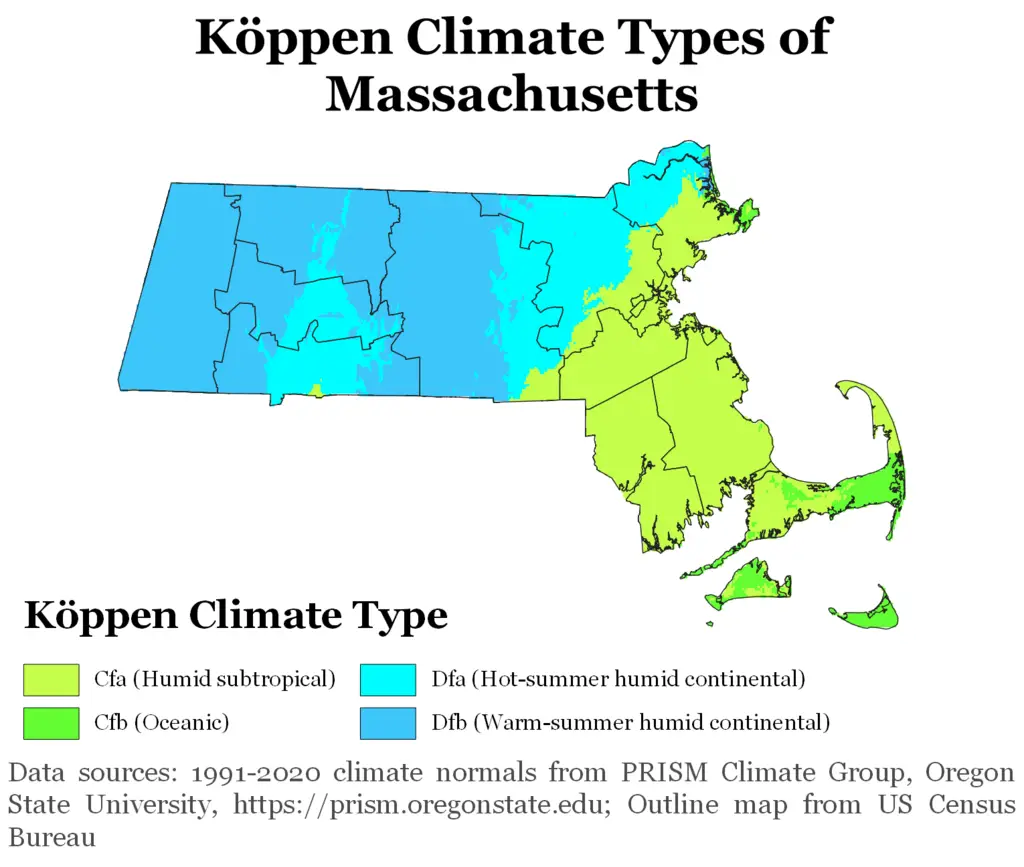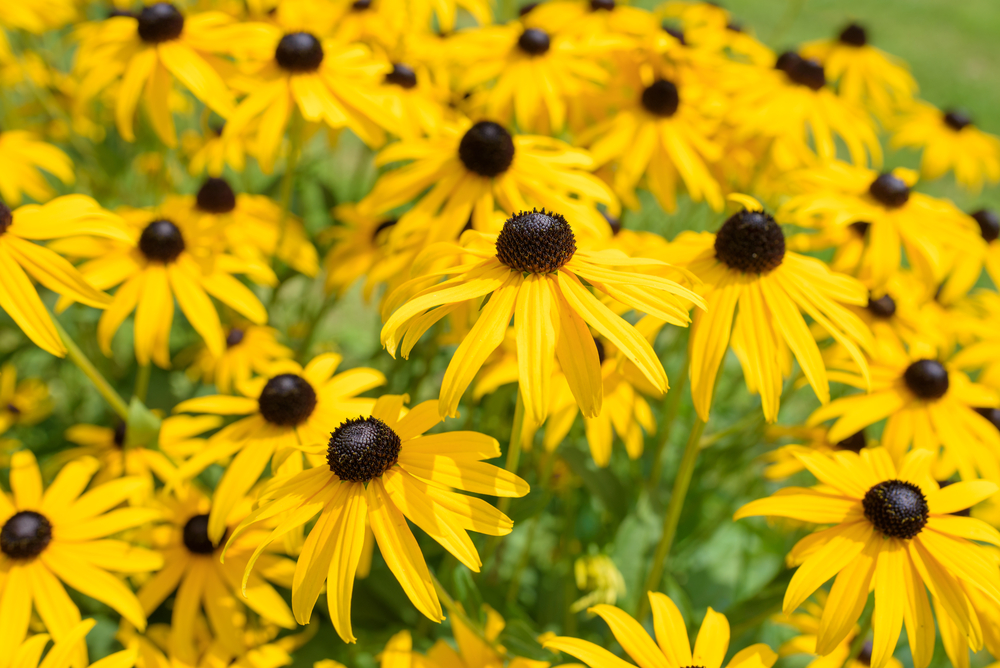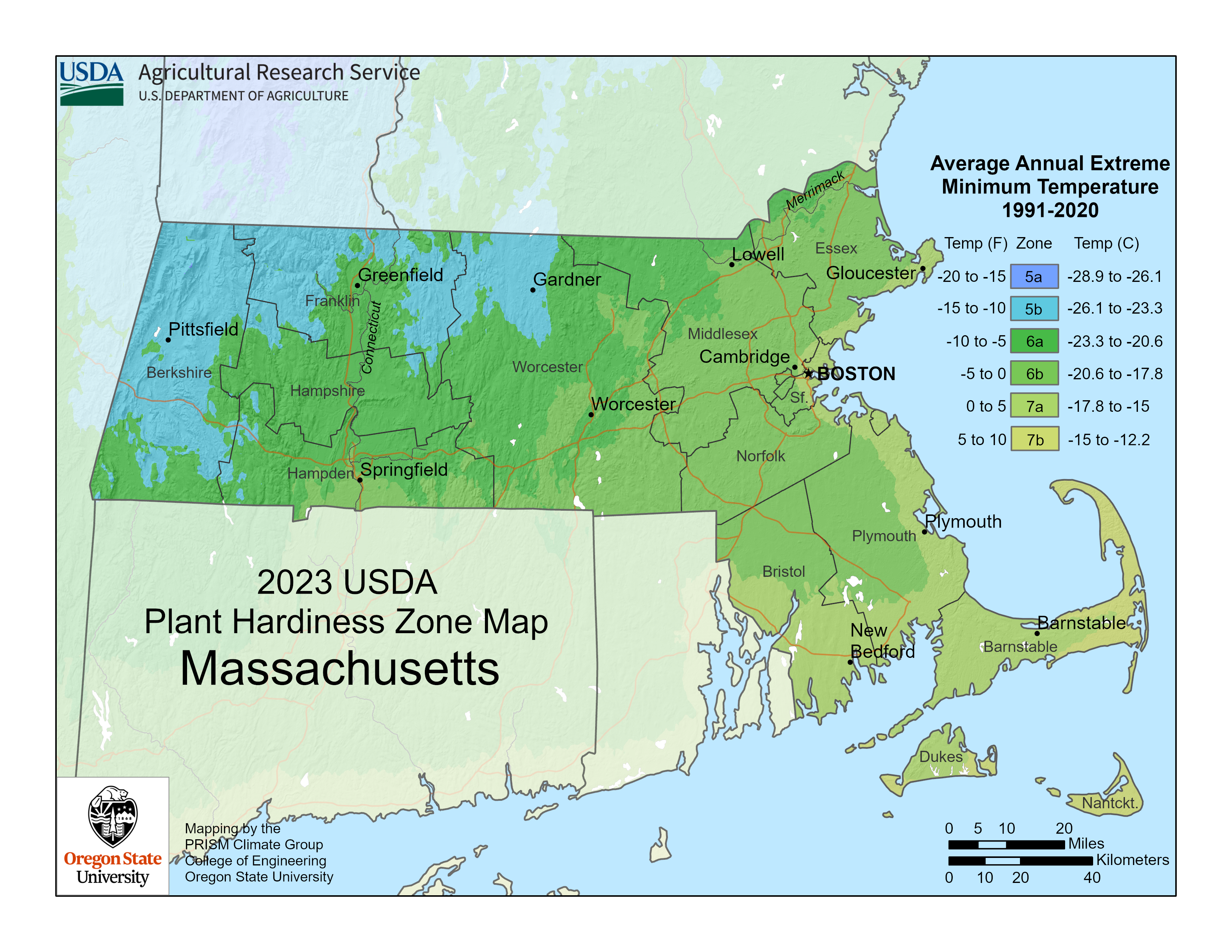Massachusetts Plant Hardiness Zones
| USDA Hardiness Zone | Average Minimum Extreme Winter Temperature Range Fahrenheit (°F)Celsius (°C) | Estimated Average Last Frost Date Range In Spring (Beginning Of The Growing Season) | Estimated Average First Frost Date Range In Autumn (End Of The Growing Season) |
|---|---|---|---|
| 5a | -20°F to -15°F -28.9°C to -26.1°C | N/A | N/A |
| 5b | -15°F to -10°F -26.1°C to -23.3°C | Early to mid-May | Early October |
| 6a | -10°F to -5°F -23.3°C to -20.6°C | Late April to early May | Early to mid-October |
| 6b | -5°F to 0°F -20.6°C to -17.8°C | Late April to early May | Early to mid-October |
| 7a | 0°F to 5°F -17.8°C to -15°C | Late April to early May | Early to late October |
| 7b | 5°F to 10°F -15°C to -12.2°C | Mid-to-late April | Early November |
Note: We listed Zone 5a as N/A because only a very small fraction of Massachusetts is in that zone, and there were no living areas within those spaces.
Massachusetts Growing Conditions
General Climate

Massachusetts’ climate ranges from continental to temperate, with the majority being continental. Particularly, the western and central portions of Massachusetts are continental, while the eastern and southern portions are temperate.
Generally, mild climates have the following defining factors:
- Located in the Northern Hemisphere (usually the upper part)
- Short growing seasons
- Cold winters
- Warm summers
- Wide ranges in temperature and weather
Generally, temperate climates have the following defining factors:
- Wide ranges in temperature and weather
- Four distinct seasons
- Warm to hot summers
- Cool to mild winters
Massachusetts generally experiences heavy precipitation throughout the year as well.
Microclimates
USDA plant hardiness zones are an important starting point for your garden, but you’ll also need to consider microclimates.
Microclimates are areas where specific conditions create a climate different from the climate they’re situated in.
Buildings, fences, paved areas, or short hills and valleys can create these microclimates.
They can be as small as a space in your backyard or as large as a city.
In other words, learn about your local conditions from local experts to see if your garden falls into a microclimate.
Extreme Weather
Blizzards
The primary characteristics of blizzards are strong winds and lots of snow. They tend to last for hours, and they can be extremely destructive. At the very least, they interfere with daily life while folks dig themselves out from the snow and make any necessary repairs.
Transporting your plants inside is one option to deal with a blizzard’s intense winds. You could also build an anchored, breathable windscreen.
Snow is not usually a bad thing, as it insulates plant roots and keeps everything hydrated. By the time snow shows up, you have likely already prepared your garden for winter and stored all tools and anything else that could be damaged.
If, however, snow arrives before trees have lost their leaves for the fall or after budding in the spring, the weight may put branches at risk of breaking. You’ll know this is a problem if you see branches weighed down. The best thing you can do is gently shake the branches or brush the snow off.
This is only occasionally an issue in the shoulder seasons of spring and fall.
Nor’easters
Nor’easters share many characteristics with blizzards and hurricanes, such as intense winds and precipitation (rain, snow, etc.).
What makes them nor’easters is the winds come from the northeast.
Unfortunately, just like blizzards and hurricanes, nor’easters can be destructive or disruptive. So, just like blizzards and hurricanes, it’s important to prepare in case they happen.
Generally, follow the same advice you’d follow for blizzards.
Flooding
Massachusetts gets quite a lot of precipitation every year, which increases with extreme weather events, such as those listed above. This can result in flooding.
Flooding can create several problems for you and your plants. Aside from potentially destroying garden structures or carrying away containers and tools, flooding also fills air pockets in the soil, depriving your plants of necessary oxygen.
Additionally, flooding can bring contaminated water into contact with your plants. In this case, you’ll need to remove those plants, especially if they’re edible.
Installing drains or rain gardens in your backyard can help you prepare for flooding. You may also want to consider strategically planting varieties that will tolerate significant precipitation.
Growing Season
Massachusetts’ growing season extends from early May to late October (depending on your zone and region). Within the range of growing seasons, this is a short to mid-length growing season.
Knowing that ahead of time allows you to set your expectations and make the most of the time you have to grow.
One way you can do that is by starting your seeds indoors. Doing so means they’ll start growing early. When temperatures are warm enough, and the last frost is past, you can transplant the seedlings to your garden!
Massachusetts Gardening Tips

Choose The Right Plants
Choosing the right plants is as essential for Massachusetts as it is for anywhere else. Depending on where you live, the plants you choose will need to be able to survive significant changes in temperature and weather.
Of course, starting with native plants is always your best bet. They’re already adapted to local conditions, and they’ll be more readily available from local nurseries and garden centers.
Prepare For A Variety Of Conditions
Massachusetts, as you’ve probably seen by now (or experienced yourself), experiences a wide variety of temperatures and weather events.
While you don’t have to go overboard, planning for these ranges helps your plants survive and do well in your garden.
For example, maybe you decide to use a cold frame or greenhouse to combat the cold winters. You could also install the aforementioned drains or rain gardens to combat potential flooding.
Even small steps are helpful, such as choosing plants that can survive those more difficult conditions or keeping a close eye on local conditions so you don’t water your plants right before a big rain.
Consult With Local Professionals
Consulting with local gardening professionals allows you to benefit from their experience with your area’s conditions, the plants that do well there, and overall best practices.
Massachusetts Plant Suggestions

Trees
- Red Maple (Acer rubrum)
- American Holly (Ilex opaca)
- White Pine (Pinus strobus)
Shrubs
- Common ninebark (Physocarpus opulifolius)
- Swamp azalea (Rhododendron viscosum)
- Inkberry (Ilex glabra)
Flowers
- Black-eyed Susans (Rudbeckia hirta)
- Magnus coneflower (Echinacea purpurea ‘Magnus’)
- Kobold blazing star (Liatris spicata ‘Kobold’)
Vegetables
- Arugula (Eruca vesicaria)
- Cauliflower (Brassica oleracea variety botrytis)
- Brussels sprouts (Brassica oleracea variety Gemmifera Group)
Herbs
- Sage (Salvia officinalis)
- Oregano (Origanum vulgare)
- Rosemary (Salvia rosmarinus)
Spices
- Cinnamon (Cinnamomum)
- Allspice (Pimenta dioica)
- Garlic (Allium sativum)
Fruits
- Fuji apple tree (Malus pumila ‘Fuji’)
- Sweetheart cherry tree (prunus avium ‘Sweetheart’)
- Bartlett pear (pyrus communis ‘Williams’)
Succulents
- Rolling hens and chicks (Jovibarba globifera)
- Hardy ice plant (Delosperma cooperi)
- Eastern prickly pear (Opuntia humifusa)
Disclaimer
Any of the above can change and is not exhaustive.
Treat anything above like a good starter guide. Then use that as a foundation as you consult with local gardeners, professionals, forecasts, guides, and organizations.
